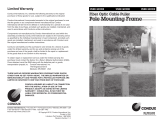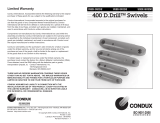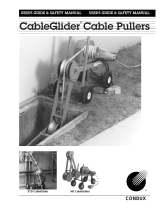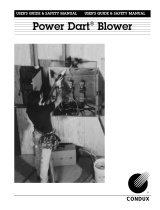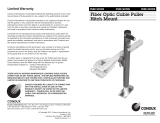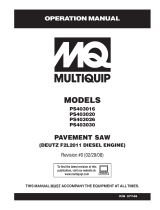Page is loading ...

Fiber Optic Cable Puller Trailer
USER'S GUIDE & SAFETY MANUAL USER'S GUIDE & SAFETY MANUAL

2
Important Safety Notice
Read and understand these usage and safety instructions before using a Condux Fiber Optic Cable
Puller Trailer. Observe all safety information on this page and note specific safety requirements as
explained by procedures called out in this manual. Failure to follow these instructions could result in
serious personal injury or death. Save this user’s guide for future reference.
®
If you have questions on:
SAFETY - OPERATIONS - APPLICATIONS
CALL 1-800-533-2077
CONDUX
ADVERTENCIA:
Favor de leer y comprender todas las instrucciones de operación y seguridad antes de usar la máquina.
Si Ud. no comprende las instrucciones favor de consultarle a su jefe.
READ MANUAL
FIRST
WEAR
HARD HAT
WEAR SAFETY
GLASSES
WEAR SAFETY
SHOES
WEAR SAFETY
GLOVES

General Information
Fiber Optic Cable Puller Trailer .....................................4
Product Specifications
General Dimensions .............................................4
Power Supply Specifications .......................................4
Hydraulic Specifications ..........................................5
Other Specifications .............................................5
Safe Operating Practices
Work Area Safety ...............................................5
Hydraulic Systems ...............................................5
Electrical Components ...........................................6
Jobsite Floor Plan
Jobsite Floor Plan Illustration ......................................6
Set Up The Trailer
Stabilizing & Leveling the Trailer.....................................7
Set up the Cable Puller
Cable Pulling from Trailer .........................................9
Cable Pulling with the Remote Mounting Stand . . . . . . . . . . . . . . . . . . . . . . . .9
Unpack the Components .........................................10
Connect the Hydraulics ..........................................10
Set up the Electronic Control System
Switch Configuration ............................................12
Connect the Electronics .........................................12
Setting up the Electronic Control Box ...............................14
Digital Chart Recorder Set up .....................................15
Data Download Instructions .......................................16
Operating the Power Unit
Fuel & Fuel Tank ...............................................16
Final Inspection ................................................17
Start the Power Unit ............................................17
When the Cable Pull is Complete
Stop the Power Unit ............................................18
Remove Pressure from Hydraulic System ...........................18
Remove Hydraulic Hoses ........................................18
Disconnect the Electronics .......................................19
Additional Takedown Procedures
Remove Capstan from the Puller ...................................19
Return Puller to Travel Position ....................................19
Load Foot Control Unit ...........................................20
Prepare Unit for Transport ........................................20
Appendices
A. Trailer Towing Safety Instructions ................................20
B. Routine Maintenance .........................................21
C. Replacement Parts ...........................................21
Table of Contents
1.
2.
3.
4.
5.
6.
7.
8.
9.
10.
11.

4
Congratulations on your purchase of the Condux Fiber Optic Cable Puller Trailer.
This unit is designed to provide a safe and efficient means to transport and
operate the Condux Fiber Optic Cable Puller (figure 1). The trailer offers the
platform for a self-contained cable pulling system including a hydraulic power
source, cable puller mounts, leveling and stabilizing hardware, and a lockable
storage area (figure 2).
This User Guide and Safety Manual will help you become more acquainted with
the features and functions of your Fiber Optic Cable Puller Trailer. As with all
Condux products, it is designed to be used only by trained craftspeople. Be
certain that you understand the operating and safety instructions in this manual
before using the equipment. Keep this manual as a permanent part of your
trailer package.
Product Specifications
A. GENERAL DIMENSIONS
Weight (wet) not including cable puller: 950 lbs.
Track: 60 inches
Overall width: 80 inches
Tongue weight: 200 lbs.
Tire Size: P205/75R14
Rim Size: 14" x 6"
Coupling Size: 3" lunette Eye
Overall Height: 51 inches
Lighting adapter: 7 pin connector
B. POWER SUPPLY SPECIFICATIONS
GAS-Briggs & Stratton V-Twin Vanguard OHV 16 h.p. gasoline engine,
electric start
Fuel requirements: unleaded fuel only, 85 minimum octane, 10% or less
ethanol blend
Fuel capacity: 5 gallons
1.
2.
Figure 1 Figure 2
General Information

5
C. HYDRAULIC SPECIFICATIONS
Capacity: 8 gpm @ 2000 psi
Reservoir capacity: 5 gallons
Filtration: 10 micron nominal
Oil Requirements: Petroleum based hydraulic oil with antiwear properties and
high viscosities over 140
Relief Valve Setting: 2150 psi
D. OTHER SPECIFICATIONS
Electronics power requirements: 12 VDC
Pulling Capacity: 1000 lbs with 30" dia. Condux capstan
Towing Requirements: Class I hitch, 200 lbs. tongue weight, 2000 gross trailer
weight
Safe Operating Practices
Your Fiber Optic Cable Puller Trailer, as with all Condux products, is designed for
safe operation; however, general jobsite safety practices must be followed. In
addition, specific safety messages are printed throughout this manual and also
appear on safety labels on the product.
A. WORK AREA SAFETY
1. Read and understand all operating instructions and safety messages before
operating.
2. Wear protective safety equipment such as: hard hat, safety glasses, safety
shoes, work gloves.
3. The safe operation of this equipment requires that the operator(s) be on
stable footing.
4. Stay clear of cable or lines under tension.
5. Be aware of the location of all underground utilities in your work area.
6. No smoking or open flame in the work area. An explosion hazard exists as
the trailer houses a gasoline tank.
B. HYDRAULIC SYSTEMS
Escaping fluids under pressure can penetrate the skin and cause serious personal
injury. Observe the following precautions to avoid hydraulic hazards:
1. Tighten all connections before applying pressure. Relieve pressure before
disconnecting hoses.
2. Check for leaks with a piece of cardboard. Do not use hands!
3. Do not exceed working pressure of hydraulic hoses.
4. Visually inspect hoses regularly and replace if damaged.
3.

6
C. ELECTRICAL COMPONENTS
The Electronic Control Box is an electrical device. Electric shock hazard exists
that could result in severe personal injury or death. Observe the following
precautions to avoid electrical hazards:
1. Do not operate in or near water. This includes setting the Electronic
Control Box on a wet surface or exposing it to rain.
2. Do not remove cover of Electronic Control Box. No user-serviceable parts
inside. Refer servicing to qualified service personnel.
3. The Electronic Control Box power switch should be in the off position before
connecting or disconnecting any cords.
Jobsite Floor Plan
A few minutes spent planning your equipment’s placement (layout) at the jobsite
will benefit both the operation of the equipment and the safety of your personnel at
the site. It is best to determine the layout of equipment before stabilizing and
leveling the trailer (section 5A). Condux recognizes that no two jobsites are the
same, but recommends a few general guidelines to get the most benefit and safest
operation from your Fiber Optic Cable Puller Trailer.
A. POSITION THE CABLE PULLER
Ultimately, the cable will be pulled from its exit point parallel to the capstan
(figure 4). Several options are available on the Condux trailer to achieve this. The
cable puller can be located in one of three mounts and rotated perpendicular or
parallel in each. Review these options using the accompanying diagrams and
determine where to position the trailer (figure 3).
B. REMOTE MOUNTING STAND
If no suitable puller position can be achieved on the trailer, a remote mounting
stand (supplied) may be used, see section 6B.
4.
LEFT SIDE CENTER
RIGHT SIDE
Figure 3

7
C. POSITION THE TRAILER
Position the trailer (in the position determined in 4A) with the tow vehicle. It is not
recommended that any other means be used to move the trailer.
Set Up The Trailer
It is essential that the trailer set-up instructions are followed in order that they
appear in this user guide and safety manual. Using the following procedures
will allow the trailer to be set up in a short period of time and yield optimum
performance.
A. STABILIZING AND LEVELING THE TRAILER
1. Use only the adjustable jacks (3 supplied, replacement jack part number
02290764) for trailer stabilizing and leveling. Jacks must be placed securely
only on jack mounts located on the trailer frame (figure 5). Do not attempt
to locate jacks in any other position! To secure a jack in position, align jack
with jack mount and insert safety pin. Raise and lower jacks by simply
rotating crank handle.
!WARNING: Chock wheels and level trailer before setting up
cable puller and other pulling equipment. Use wheel chocks and
all three leveling jacks as described in the procedure below.
Failure to properly level trailer may result in the trailers unexpected
movement causing severe personal injury and equipment damage.
20°
ECB
OPERATOR
FOOT CONTROL
HAZARD AREA
Figure 4
5.

8
2. Begin to stabilize the trailer by placing a wheel chock (2 supplied) behind
each trailer wheel (figure 6).
!WARNING: Load must be distributed evenly before unhitching
trailer. Failure to do so may cause the trailer tongue to flip upward
causing severe personal injury.
3. Remove trailer from tow vehicle. The trailer should be in position for cable
pulling at this time (section 4). Use an adjustable jack on the front frame
jack mount to lift the trailer from the tow vehicle (figure 7). Place jack in
jack mount as described in section 5A-1 and then disconnect ball hitch or
other hitch mechanism. Then lift trailer from tow vehicle by using the crank.
Raise no more than necessary to clear tow vehicle.
4. One jack will remain on the tongue of the trailer. Place the last two jacks at
the rear corners of the trailer. Placement of rear jacks is critical to avoid
getting in the way of the pulling equipment. Note that there are two jack
mounts provided at each rear corner (figure 8).
5. Level the trailer by using the crank handles on the jacks. Raise and lower
each jack to provide a level surface for the cable pulling equipment.
Figure 7 Figure 8
Figure 5 Figure 6

9
Set Up The Cable Puller
A. FOR CABLE PULLING FROM TRAILER
Move the cable puller from the travel position, if necessary, to achieve the best
possible pulling position as determined in section 4. There are two steps to
achieve this.
1. Change the placement of the cable puller on the trailer bed by inserting the
puller into one of the two mounting holes on the side rails of the trailer
frame. Note that the center (travel) position on the trailer bed already has
its own mount. Pin the mount from below the trailer bed. Lower the cable
puller on the mount.
!CAUTION: The cable puller is heavy (125 lbs.). Lift only with
proper equipment or sufficient man power. Personal injury may
result if improper lifting practices are used.
2. Adjust the cable puller on the mount, corner positions only (figure 9). Align
holes in mount and cable puller. Place the lock pin (supplied) through the
entire mount and hook to secure the cable puller.
B. FOR CABLE PULLING WITH THE REMOTE MOUNTING STAND
In the event that the trailer cannot be positioned for optimum cable pulling
operation, you may choose to use the remote mounting stand integrated on the
trailer bed.
1. Remove the cable puller from the remote mounting stand first. Do not
attempt to remove the remote mounting stand from the trailer bed with the
cable puller attached.
2. Use a 1 1/8" wrench to remove the bolts securing the remote mounting
stand to the trailer bed (figure 11).
3. Position the remote mounting stand on a level surface for cable pulling.
Follow the guidelines in section 4.
4. Loosen the two screw-knobs on the base and slide the support tubes until
centered. Retighten the two screw-knobs.
6.
Figure 9 Figure 10

10
5. Mount the cable puller on the remote mounting stand. Be sure the capstan
is placed between the support tubes, not over the support tubes (figure 12).
C. UNPACK THE COMPONENTS
1. Remove the capstan from its storage rack and place on the cable puller.
Align slots on capstan with pins on shaft and push on (figure 10). The
capstan sleeve contains a spring that must be compressed all the way,
then rotate clockwise until the capstan springs into place over the shaft
pins. The pins on the shaft must be visible through the holes in the capstan
sleeve. You should not be able to rotate the capstan at this point if it is
properly installed.
2. Remove the foot control and hydraulic hoses from the trailer bed. Set aside
for connection later.
3. Remove the Electronic Control Box, if equipped, and its power cord
(supplied). Set aside for connection later.
D. CONNECT THE HYDRAULICS
!WARNING: Escaping fluids under pressure can penetrate the
skin and cause serious personal injury. Observe the following
precautions to avoid hydraulic hazards:
1. Tighten all connections before applying pressure. Relieve
pressure before disconnecting hoses.
2. Check for leaks with a piece of cardboard. Do not use hands!
3. Do not exceed working pressure of hydraulic hoses.
4. Visually inspect hoses regularly and replace if damaged.
Figure 11 Figure 12

11
The hydraulic system on your Condux Fiber Optic Puller Trailer allows easy,
accurate connections of hydraulic hoses for the foot control and power supply
(figure 13). All connect points must be kept clean! Use the following steps to
connect your hydraulic components:
1. Connect the foot control to the power unit. You’ll find male and female quick
couplers on the hose ends that mate to the foot control.
2. Connect the foot control to the cable puller. Use the male and female quick
couplers on the hose ends to make the connection (figure 14).
CABLE
PULLER
FOOT
CONTROL
POWER
SUPPLY
QUICK COUPLERS
FACTORY CONNECTIONS
PRESSURE
RETURN
Figure 13 Figure 14

12
Set Up the Electronic Control
System
If the puller is not equipped with the electronic tension control system, go to
section 8.
A. SWITCH CONFIGURATION
Following is a brief explanation of each of the switches for the Condux Fiber Optic
Cable Puller Electronic Control System. Detailed instructions for using the
equipment follows these explanations.
1. Electronic Control Box Panel Switches (figure 15)
Power: Turns control box ON or OFF.
Set Tension Limit: Sets the limit where the control box will stop the puller.
Press and hold UP or DN button to set the desired value.
Tension Limit Control: Determines if the puller will stop rotating when the preset
tension limit is reached. Switch to ON to activate the
hydraulic bypass valve and stop the puller when the
tension limit is reached. Switch to OFF to disable the
hydraulic bypass valve.
Zero Display: Set the display to zero before beginning. Press “Prog”
button to zero display.
Capstan Selection Switch:
Sets the control box to display the proper pulling forces
depending on the size capstan used. Turn switch to set
desired capstan diameter. The meter automatically
calibrates the displayed force to the selected
capstan size.
Limit Reset: Resets the control box and puller after the preset tension
limit has been exceeded. Press button to reset hydraulic
bypass valve and audible alarm. This can be done only
when the tension is below the preset limit.
B. CONNECT THE ELECTRONICS
!DANGER: The electronic control box is an electrical device. Electric shock
hazards exist that could result in severe personal injury or death. Observe
the following precautions:
Figure 15
7.

13
• Donotexposeelectroniccontrolboxtowater.
• Donotremovecoverofelectroniccontrolbox(nouser-serviceableparts
inside). Refer servicing to qualified personnel.
• Theelectroniccontrolboxpowerswitchshouldbeintheoffposition
before connecting or disconnecting any cords.
1. Connect the male end of the 5-pin sensing cord to the female connector on the
Electronic Control Box labeled “LOAD CELL”. (figure 16) Connect the female end
of the cord to the male receptacle located near the load cell. (figure 16a). Before
making these connections, ensure the receptacles are free of dirt and moisture.
Do not modify this cord’s length.
Tighten the connector collars over the threaded portion of the receptacles. This
prevents the cord from coming loose during operation. This cord is necessary to
measure the tensions sensed by the load cell.
2. Connect the male end of the 3-pin footswitch control cord to the female connector on
the Electronic Control Box labeled “FOOTSWITCH” figure 16b). Connect the female
end of the control cord to the male receptacle located on the foot control valve
assembly figure 16c). NOTE: If the connector on the foot switch is 2-pin, use the patch
cord (08675926) included in the upgrade kit (08675920) to convert to the required
connection. Before making these connections, ensure the receptacles are free of dirt
and moisture. Do not modify this cord’s length.
Figure 16 Figure 16a
Figure 16b Figure 16c

14
Tighten the connector collars over the threaded portion of the receptacles. This
prevents the cord from coming loose during operation. This cord is necessary to
measure the tensions sensed by the load cell.
3. The 7⁄8" 2-pin connector on the front
panel of the electronic control box
supplies electrical power to the
electronic control box. (figure 16d)
This power can come from the power
pack, a vehicles power point, or a
lighter socket. The electronic control
box requires 12 Volt DC power for
proper operation.
4. Connect the power cord to the 2-pin
connector labeled “POWER”. Before
making these connections, ensure the
receptacle is free of dirt and moisture.
Tighten the connector collar over the
threaded portion of the receptacle. This
will prevent the cord from coming loose during operation. Connect the other end of
the power cord to a 12 Volt DC power source.
C. SETTING UP THE ELECTRONIC CONTROL BOX
The Condux Fiber Optic Tensiometer has been designed to give the operator
continuous tension information and automatic shut-off control during a pull. The
Electronic Control Box features an LED Display, Digital Graph Display, 256MB
Flash Card, and a 3 capstan selection switch. A programmable overload set point
with both visual and audible alarms is designed to disengage the cable puller
should an overload occur. Navigator software is provided so pulling information
can be downloaded onto any computer running Windows 2000® or XP®.
!DANGER: The Main Power switch supplies power to the indicator and chart
recorder. When a power supply is connected to the electronic control box,
portions of it are energized. Follow all electrical equipment precautions.
!NOTE: Always disconnect the power cord when the electronic control box is not in
use. When the power cord is connected to the electronic control box, it energizes
portions of the control box. If the power cord is left attached when the control box
is not in use, it will drain the power supply.
1. Turn the power switch on the Electronic Control Box to the “ON” position
(figure 15). Be sure that the sensor cords are properly connected before turning
on power.
2. Select the capstan size. Turn the capstan selection switch so the appropriate
channel is lit on the Meter. In order to get accurate results, the correct capstan
size must be selected. The electronic control box is programmed to accurately
return pull tension for Condux 12", 30", and 42" fiber optic capstans.
3. Set the cable Tension Limit. Press the “Prog” Button and ▼ button
simultaneously. (figure 15) SP-1 will appear on the on the LED Screen. The
screen will alternate between SP-1 and the current tension limit. Press the
▲ and ▼ buttons to increase or decrease the tension limit. Once the desired
tension limit is set, press “Prog” to save the set point.
Figure 16d

15
4. Zero the display. Press the “Prog” button.
5. Alarms: When Tension Limiter switch is in the “OFF” position the audio alarm
will sound and the light will come on when the tension limit is reached. When
the Tension Limiter switch is in the “ON” position the puller will also stop pulling
when the tension limit is reached (figure 5)
!CAUTION: Damage to cable may result from excessive pulling forces. Use
precautions to safeguard against overload conditions.
D. DIGITAL CHART RECORDER SET UP
The Digital Chart Recorder is the next generation Solid State Data Recorder/Panel
Recorder. This instrument has all the capability of a traditional paper recorder –
variable chart speeds, the ability to review historic data, see trends and more. All
pull data is stored on the 256MB Compact Flash Card that comes with the unit.
1. Name File Press “MENU” button to enter the Menu screen. Use ▲ and ▼
arrows to scroll to RECORD MODE and press menu. Next, scroll to “NAME
FILE” and press MENU. Use the ▲ and ▼ buttons to scroll through letters and
the ◄ and ► buttons to move spaces. (figures 16e-h). Once the name is set
press “MENU” button to go back to Record Mode. From Record Mode, ◄ or ►
will return to Menu screen. Pressing ◄ or ►again will return to charting screen.
Figure 16e
Figure 16g
Figure 16f
Figure 16h

16
Operating The Power Unit
A. FUEL AND THE FUEL TANK
For optimum performance of the power unit, follow these instructions regarding
fuel and the fuel tank:
1. For gas units use only unleaded gasoline with a minimum octane rating of
85. Ethanol blended fuels must contain 10% or less ethanol. Do not add
oil to gas.
8.
2. Set to Record Mode: If you are already in the Record Mode screen, use the ▲
and ▼ buttons to scroll to “ON”. If you are starting from the charting screen,
press “MENU” and scroll to Record Mode. Press “MENU” again to enter Record
Mode, and scroll to ON. Push the “MENU” button to put a check mark next to
“ON”. Your unit is now ready to record. The red light on the Chart Recorder
panel should turn on when unit is recording. Press the ◄ or ► to return to the
Menu screen. Press ◄ or ► again to get back to the charting screen.
!NOTE: The recorder is time based, meaning if the recorder is not switched to
"OFF" between pulls, the data recorder will report long time periods of zeros.
3. Set Sample Rate: Press the “MENU” button and the menu screen will appear.
Using the ▲ and ▼button, scroll to SAMPLE RATE. Press the “MENU”
button and your list of sample rate options will appear. Select the sample rate
you desire and press “MENU” to select. Press the ◄ or ► buttons twice to get
back to the charting screen.
!NOTE: See Data Chart 1250 Manual on included CD for more information.
E. DATA DOWNLOAD INSTRUCTIONS
The Running Line Tensiometers come with accessories for downloading your pull
data: Navigation software, 256MB Flash Card, card reader and USB cable.
Downloading data to your computer via USB Cord
1. Connect Recorder to PC or laptop with supplied USB cord
2. Turn ECB on *and make sure that Record Mode has been turned to OFF.
3. Open Navigator software on PC
4. In Navigator software select “FILE” and “USE RECORDER”
5. Select Open to pull in pulling data from recorder.
6. Select your file and click “OK”
Downloading data to your computer via Flash Card
1. Plug card reader into the PC’s USB connection.
2. *Make sure that Record Mode has been turned to OFF. Remove Flash Card from
ECB recorder and install into the card reader.
3. In Navigator software select open
4. A file screen will appear. Locate the removable drive and select pull data file.
5. Double click pull data file to load into Navigator software.
See Navigator Software manual for additional information.

17
!DANGER: No smoking or open flame in the work area. An
explosion hazard exists as the trailer houses a gasoline tank.
B. FINAL INSPECTION BEFORE STARTING POWER UNIT
1. Inspect the jobsite for safe equipment layout.
2. Be sure the trailer is stable and level.
3. Supply all jobsite personnel with safety equipment (section 3).
4. Check engine oil level. See Briggs & Stratton Owner’s Manual (supplied).
5. Check hydraulic fluid level.
6. Check hydraulic connections.
7. Check electronic connections if using the Electronic Control Box.
C. START THE POWER UNIT
1. Turn on the ignition switch.
2. The Hydraulic Power Pack has an electric starter. The battery must be
charged to start engine. Jump starting is not recommended.
3. Begin the cable pull. There is no information in this manual on the
operation of the Condux Fiber Optic Cable Puller. You must read and
understand all operating instructions and safety messages in the
Condux Fiber Optic Cable Puller User Guide & Safety Manual
(Part No. 08675199) before operating that equipment (figure 17 & 18).
Figure 17 Figure 18

18
When The Cable Pull Is Complete
A. STOP THE POWER UNIT
1. Turn throttle control to the slow position.
2. Turn the ignition switch for the power unit to the off position.
!WARNING: Escaping fluids under pressure can penetrate the
skin and cause serious personal injury. Observe the following
precautions to avoid hydraulic hazards:
1. Relieve pressure before disconnecting hoses.
2. Check for leaks with a piece of cardboard. Do not use hands!
B. REMOVE PRESSURE FROM HYDRAULIC SYSTEM
Lift up and down on the foot control pedal to relieve
back pressure in the hydraulic system. Repeat at least
3 times to ensure relief. Do not disconnect hoses
under pressure!
C. REMOVE HYDRAULIC HOSES
It is extremely important that all hydraulic connections be kept free of dirt and
particles (figure 19). Use hose end caps (supplied). A contaminated hydraulic
system will affect the operation of the cable puller and may invalidate your
product warranty.
1. Using the quick couplers, disconnect power supply hose at the foot control.
Cap the power supply hose and place on hose rack. Do not disconnect the
power supply hose at the power unit (figure 20).
2. Using the quick couplers, disconnect the foot control feed line at the cable
puller. Cap all ends.
CABLE
PULLER
FOOT
CONTROL
POWER
SUPPLY
QUICK COUPLERS
FACTORY CONNECTIONS
PRESSURE
RETURN
Figure 19 Figure 20
9.

19
D. DISCONNECT THE ELECTRONICS
!DANGER: The Electronic Control Box is an electrical device.
Electric shock hazard exists that could result in severe personal
injury or death. Observe the following precautions to avoid
electrical hazards:
1. Do not remove cover of Electronic Control Box. No user
serviceable parts inside. Refer servicing to qualified
service personnel.
2. The Electronic Control Box power switch should be in the off
position before connecting or disconnecting any cords.
1. Turn off Electronic Control Box before disconnecting any cords.
2. Remove power supply cord at the power pack and Electronic Control Box.
Wrap and stow in trailer.
3. Disconnect the Electronic Control Box control cord at the cable puller. Do
not disconnect the control cord at the Electronic Control Box, it is
permanently attached.
Additional Takedown Procedures
A. REMOVE CAPSTAN FROM CABLE PULLER
1. Push in on the capstan and rotate counterclockwise until it springs
out slightly.
2. Align slot on capstan with the pins on spindle and pull off.
3. Mount the capstan on the trailer by sliding the hub of the capstan over the
spindle mount on the trailer (figure 21). Capstan must be mounted exactly
as shown to prevent damage. Tie down with strap (supplied). Span a
minimum of three capstan spokes with the tie down strap for a tight fit.
!CAUTION: The cable puller is heavy (125 lbs.). Lift only with
proper equipment or sufficient man power. Personal injury may
result if improper lifting practices are used.
B. RETURN CABLE PULLER TO TRAVEL POSITION
Follow the procedure below if you have moved the cable puller from its travel
position. If you have used the remote mounting stand, it must be secured back on
the trailer before returning the cable puller to the travel position.
1. The center position is the only travel position recommended for the cable
puller. This mount does not require the additional mount used for the side
mount locations.
2. Lower the cable puller onto the center mount and pin in place. The cable
puller must travel with the capstan spindle pointing toward the
passengers side of the trailer (figure 21). Other components will not stow
properly if this position is not used.
10.

20
C. LOAD FOOT CONTROL UNIT
Set foot control into travel hold on trailer bed (figure 22). Place hoses in
storage box.
D. PREPARE UNIT FOR TRANSPORT
1. Stow remaining equipment in compartment on trailer.
Trailer Towing Safety Instructions
!WARNING: Observe the following safety instructions when
transporting the Condux Fiber Optic Cable Puller Trailer. Observe
local, state, and federal laws governing trailer towing. Also follow
the tow vehicles operating instructions for trailer towing. Failure to
do so may result in severe personal injury and equipment damage.
1. Check that coupler hitch and ball or pintle hitch and hook are correct size.
2. Adjust trailer tongue to proper hitch height.
3. Secure fiber optic puller and capstan.
4. Disconnect electronics and turn off power pack.
5. Check trailer load for balance and capacity.
6. Attach trailer to towing vehicle.
7. Latch and lock ball coupler or pintle hook.
8. Cross safety chains beneath hitch and attach to towing vehicle.
9. Connect and check lighting.
10. Remove leveling jacks.
11. Remove wheel chocks.
12. Tighten wheel lug nuts and check tire pressure.
A.
APPENDIX
Figure 21 Figure 22
/
